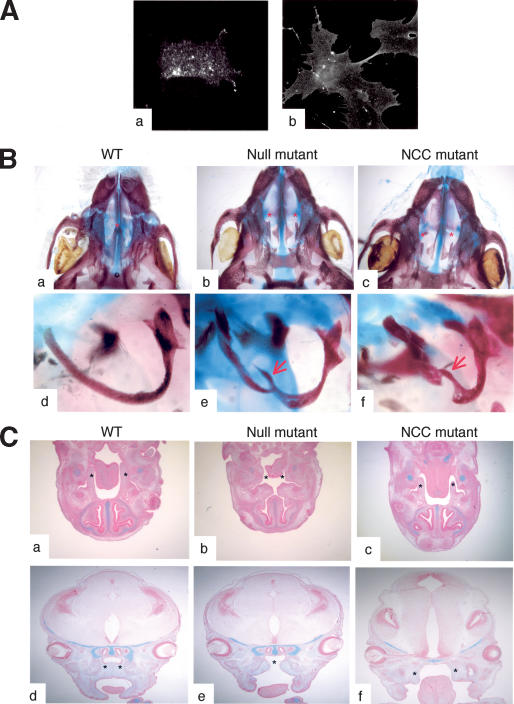Figure 4.
Ephrin-B1 acts autonomously in neural crest cells. (A) Primary cells isolated from branchial arches of E10.5 wild-type embryos were passaged once and analyzed by immunofluorescence using the ephrin-B1-specific antibody (25H11; panel a) or the ephrin-B1-Fc recombinant protein to detect EphB receptors (panel b). (B) Alcian blue/Alizarin red-stained skeleton preparations of wild-type (panels a,d), ephrin-B1null (panels b,e), or ephrin-B1NCC (panels c,f). Palatal shelves (asterisks) are fused in the wild-type animal (panel a), but remain separated in ephrin-B1null (panel b) and in ephrin-B1NCC (panel c). Tympanic rings are defective bilaterally in ephrin-B1null (panel e) and in ephrin-B1NCC (panel f). (C) Histological sections of wild-type (panels a,d), ephrin-B1null (panels b,e), or ephrin-B1NCC (panels c,f), stained with Alcian blue and Nuclear Fast red. (Panels a–c) At E13.5, palatal shelves (asterisks) can be observed on transverse sections on each side of the tongue of wild-type (panel a) and NCC-deleted ephrin-B1 mutant (panel c). (Panel b) Embryo-wide deletion of ephrin-B1 precludes formation of palatal shelves. (Panels d,e) At E15.5, palatal shelves have elevated and fused (asterisks) in wild-type embryos (panel d). (Panel e) In ephrin-B1null embryos, the roof of the mouth has elevated but no palatal shelves are present. (Panel f) At E14.5, palatal shelves (asterisks) are formed in ephrin-B1NCC mutants, but they failed to elevate.

